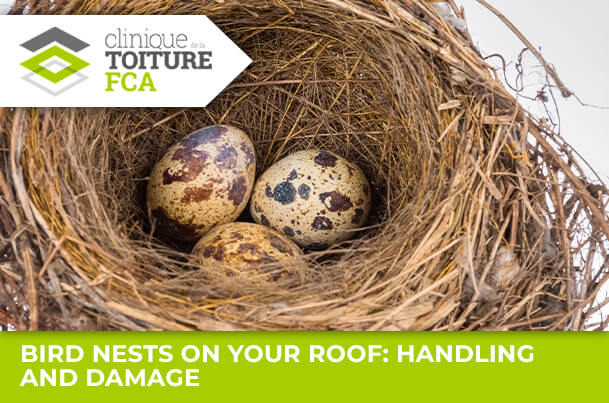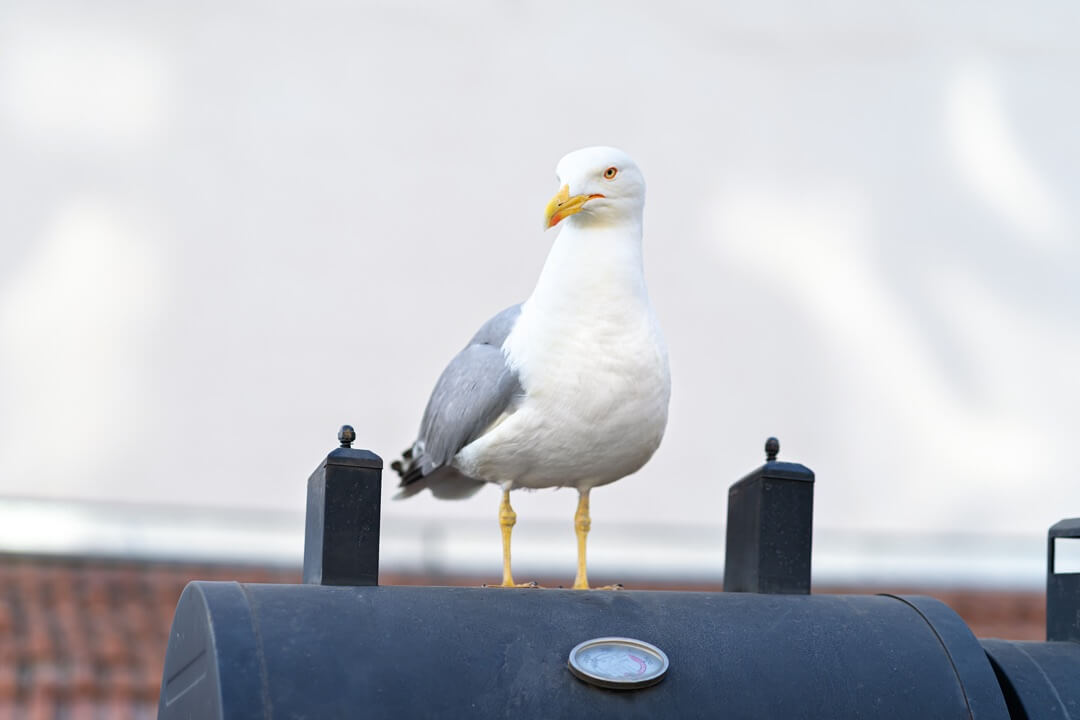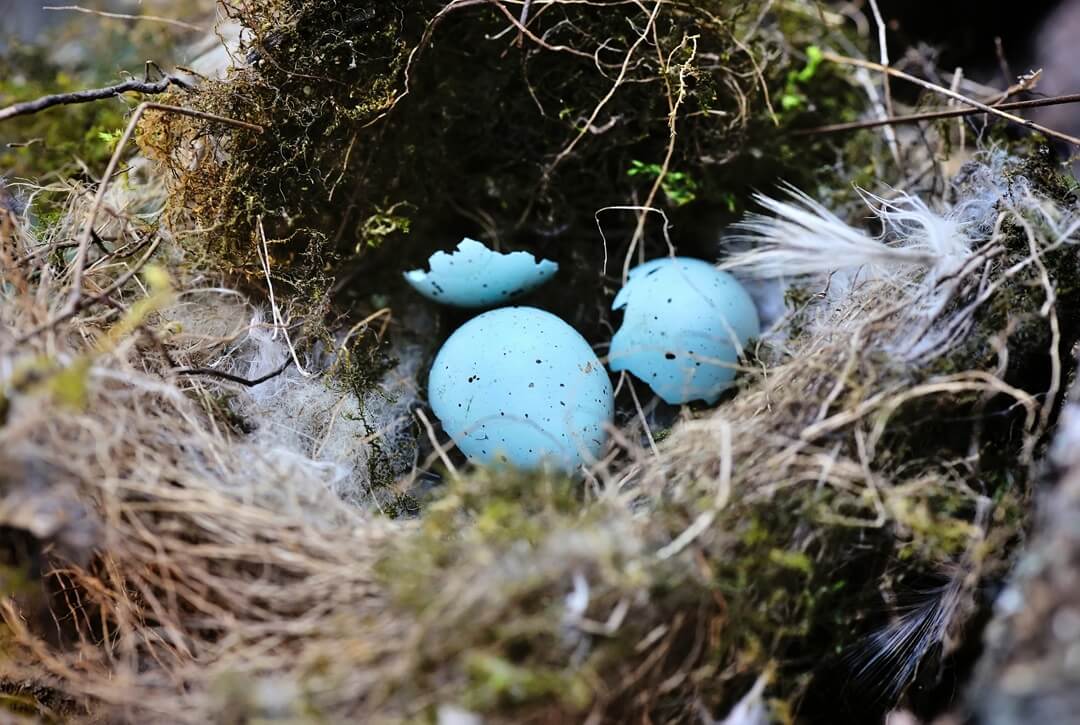
Home > Blog posts > Bird nests on your roof: what to do and what are the possible damages?
Bird nests on your roof: what to do and what are the possible damages?
Bird songs usually bring to mind the warm season, the arrival of summer and the beauty of nature. When spring finally turns the corner, you can also be mesmerized by the lovely bird nests on your roof. Yet those who have experienced this also know that it is not a gift from the heavens: birds and their nests can also become a real nuisance for your roofing.
So, what are the real consequences of having a bird’s nest on your roof? What can you do to fix this situation or avoid it altogether?
What kind of damages do bird nests cause to your roofing?
Even if birds can seem truly harmless, they can cause very real damages to your roof, should they choose to make their home on it!
Firstly, the nest itself can cause several damages, simply by obstructing water flow. This is especially true if the birds have made their home close to a gutter or a drain. It is also the case even if the nests were made elsewhere, since the wind can blow whatever materials have been used to make them into the surrounding drains or gutters and cause blockages.
A blocked drain translates into water infiltration risks, including water seeping into the walls of your home. There can also be damages caused to your roof, and even in the overall structure of your house. Mold can also appear with time. If your roof is flat, it is especially important not to let birds build nests or allow residues to block the drains.
If bird nests impede on water flow, they can also obstruct air flow, by blocking vents and ventilation. Bad ventilation means humidity, which in turn translates into roof and structure damages. You should also take into account that the materials birds use to make their nests are flammable (grass, twigs, moss) and that they are a very real fire hazard!
Finally, one of the more obvious downfalls of having bird nests on your roof are the droppings your guests will be leaving everywhere. Bird droppings are very acidic: they cause damages to materials like asphalt, but also to heating, air-conditioning and ventilation systems.
Moreover, their droppings work as a fertilizer for moss and algea, which can encourage them to grow on your roof and lead to your roof aging way before its time.
Contact us now for a roof inspection

How can you prevent birds from making nests on your roof?
Do you want to scare birds off your roof or better yet, make sure they don’t build their nests on your roof at all? There are many ways to do this without harming any creatures.
Decoys
The same way you would use a scarecrow in the garden to scare off birds who want to eat your crops, you can also opt for decoys on your roof. In fact, you can trick birds into thinking that one of their predators if cozying up on your roof, and they will avoid it altogether.
This is simple: purchase a plastic decoy (similar to one of their predators) and install it on your roof.
Small birds, for example, scare easily when they spot a raven, which is their main predator. The falcon is a predator to doves, sparrows and pigeons, while the owl is a predator to many types of other birds like:
- Crows
- Seagulls
- Sparrows
- Pigeons
Using decoys can be efficient when trying to dissuade birds from landing on or building nests on your roof. The most efficient decoys are those that reflect light. You can also get creative and add moving parts to your decoys, which will only make them even more convincing.

Repellents
While a decoy is used to imitate a predator’s physique and silhouette through shape and size, it is just as efficient to imitate a predator’s cry! In fact, playing soundtracks imitating the sounds predators make can be enough to alert other birds to their presence. Ultrasounds can also be used if you wish to avoid noise pollution, as long as they are not harmful to other neighborhood pets.
You can use other repellents, such as gels, that can be spread on the roof shingles or tiles. Repellent gels, just as their name indicates, work by dissuading birds from landing on your roof. You will have to reapply the gel every 6 to 8 months for this technique to remain efficient.
As mentioned above in the case of decoys, all materials that reflect light also work as an efficient repellent. In other words, they serve to scare the birds away. In this case, you do not need to recreate the shape of an animal: several objects can be used, like, for example:
- Aluminum strips
- Old CDs
- Small mirrors
- Tin cans
If you place these close to a bird’s nest on your roof, birds will generally abandon the nest and go build one somewhere else.

Bird netting
Whether you wish to protect your entire roofing or simply a few strategic areas (like the gutters or the ledges), bird netting is an excellent option. On top of efficiently dissuading birds from landing on your roof or making nests, they are a durable solution, albeit more expensive. Moreover, there are several available options on the market that can blend in and match your roof color.
Bird netting does not capture birds, it simply stops birds from landing on your roof.
Bird control spikes
Rest assured, it is not a question here of being harmful to birds! These spikes are very efficient in dissuading birds –especially pigeons- from landing on your roof, simply by creating an inhospitable environment. They consist of long plastic or stainless steel needle-like rods that are generally placed on overhangs or window sills.
Without harming them, the spikes make the environment uncomfortable for the birds, who will not want to land or will simply be unable to. Other similar alternatives exist, like a metal bird spider, made of flexible rods placed in a circle, and which works in the same way.
How to remove a bird nest from your roof?
Have your attempts to prevent this from happening failed, or perhaps you’ve waited too long before acting? We understand that you now want to remove the bird nests from your roof; however, in many cases, you won’t be able to do so immediately. In fact, birds are protected by law, just as their nests are and the eggs they contain.
Here are the steps you need to follow to remove a bird nest:
- Before attempting to remove a bird nest, make sure that the nest is inactive, which generally occurs after mating and nesting season is over. To find out exactly when this is, you will have to identify the bird species. You can also remove a nest that is not in use, is old and uninhabited, or in a dangerous state.
- Avoid contamination. Wearing gloves is very important when removing a nest: there can be parasites, mites or various other insects in a nest.
- Place the nest in your compost bin or in a plastic bag: you’ll want to make sure not to attract predators!
- Clean the nesting area. To do this, use a mixture of chlorine and water (1 part chlorine for 9 parts water) and let it air dry. Cleaning the area can also help you avoid other damages to your roof.

For more advice on roof maintenance for your flat roof, or on how to make repairs, do not hesitate to contact us at Clinique de la toiture FCA. Do you have roof damages due to birds? Act quickly: we are here to help.
Don't wait any longer: ask us for a quote!
Get an estimate in just 2 quick steps!
*Please allow a minimum of 24 hours for your request to be processed. Thank you for your understanding!
Testimonials and reviews from our customers
Trustindex vérifie que la source originale de l'avis est Google. Nous sommes très satisfaits des travaux qui ont été exécutés par l'équipe de la Clinique de toiture FCA. Nous avons eu des suivis rapprochés et la date des travaux fût respectée. Merci à toute l'équipe.Trustindex vérifie que la source originale de l'avis est Google. Nice job - professional team Happy to work with them Highly recommendedTrustindex vérifie que la source originale de l'avis est Google. Nous avons eu un excellent service, de l’inspection à l’exécution des travaux. Nous avons eu des photos avant et après les travaux. Je recommande cette entreprise!Trustindex vérifie que la source originale de l'avis est Google. Très satisfaite de l'efficacité de la compagnie, j'ai reçu toutes les réponses à mes questions. Merci à toute l'équipe.Trustindex vérifie que la source originale de l'avis est Google. Travail de professionnels. Entreprise à recommander.Trustindex vérifie que la source originale de l'avis est Google. L'équipe de Clinique de la Toiture FCA a fait un travail exceptionnel sur ma toiture. Le chantier a été nettoyé rapidement et efficacement, et le résultat final est impeccable. Je suis très satisfaite de la qualité du travail et du professionnalisme de l'équipe. Je recommande vivement cette entreprise à tous ceux qui ont besoin de travaux de toiture.Trustindex vérifie que la source originale de l'avis est Google. Excellent service: professionnel, courtois et efficace. Bon rapport prix et qualité du produite. Aucune hésitation à recommandé la Clinique de la Toiture.Trustindex vérifie que la source originale de l'avis est Google. La réfection de la toiture de l'immeuble a été faite en 2019 et nous sommes très satisfait d'avoir choisi la Clinique de la Toiture FCA. Des produits de haute qualité et un service après vente hors pair. On a eu une urgence dernièrement d'une fissure de la membrane à cause d'une terrasse en bois mal posée. J'ai appelé en urgence la Clinique de la Toiture FCA pour éviter des dégâts d'eau importants. L'estimateur Yohan Fournier, courtois et respectueux, a su contenir mon impatience et a fait une réparation temporaire en colmatant cette fissure. Quelques jours plus tard, l'équipe de Yohan est venue tout réparer à notre satisfaction. Leur approche au service du client est exemplaire. Je recommande leurs services et savoir-faire sans hésiter.Trustindex vérifie que la source originale de l'avis est Google. Nous sommes entièrement satisfaits de vos services, de la première rencontre avec votre estimateur qui nous a mis en confiance, à la réalisation des travaux qui a répondu à toutes nos attentes. Merci pour une toiture bien faite et performante. On sent déjà un meilleur confort dans les appartements situés au 2e étage. Nous vous recommandons à tous.
Need help?
Leave us your email address and we will contact you as soon as possible to assess your needs!
Put an end to your water infiltration your clogged drains your roof problems
Leave us your email address and we will contact you as soon as possible to assess your needs!
